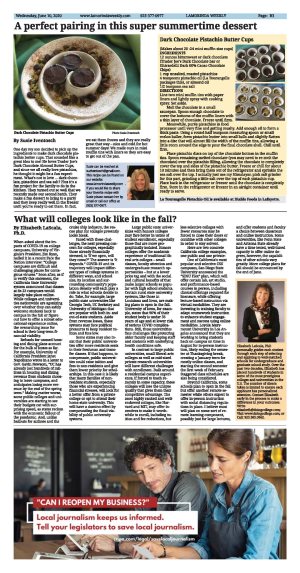| | Published June 10th, 2020
| What will colleges look like in the fall?
| | By Elizabeth LaScala, Ph.D. | |  | | Elizabeth LaScala, PhD personally guides each student through each step of selecting and applying to well-matched schools for undergraduate and graduate school study. Over the past two decades, Elizabeth has placed hundreds of students in some of the most prestigious colleges and universities in the U.S. The number of clients taken is limited to ensure each applicant has personalized attention. Contact Elizabeth early in the process to make a difference in your outcomes. Write elizabeth@doingcollege.com; Visit www.doingcollege.com; or Call: 925.385.0562. |
When asked about the impacts of COVID-19 on college campuses, University of Virginia's President, Jim Ryan, nailed it in a recent Face the Nation interview: "College campuses are difficult and challenging places for contagious viruses." Soon after, as if to verify this statement, the California State University system announced that classes at its 23 campuses would largely take place online. While colleges and universities nationwide are agonizing over whether they can safely welcome students back to campus in the fall or figure out how to offer a robust educational experience online, the overarching issue for school is their long-term financial viability.
 Refunds for unused housing and dining plans account for the bulk of losses so far. For example, University of California President Janet Napolitano wrote in a letter to Gov. Gavin Newsom, "UC has already lost hundreds of millions in housing and dining revenue from students choosing to leave campuses, and anticipates losing more revenue by the end of the spring term." Making matter worse, some public colleges and universities are starting to see their budgets cut with surprising speed, as states reckon with the economic fallout of the pandemic. And, unlike bailouts for airlines and the cruise ship industry, the rescue plan for colleges presently looks bleak.
Refunds for unused housing and dining plans account for the bulk of losses so far. For example, University of California President Janet Napolitano wrote in a letter to Gov. Gavin Newsom, "UC has already lost hundreds of millions in housing and dining revenue from students choosing to leave campuses, and anticipates losing more revenue by the end of the spring term." Making matter worse, some public colleges and universities are starting to see their budgets cut with surprising speed, as states reckon with the economic fallout of the pandemic. And, unlike bailouts for airlines and the cruise ship industry, the rescue plan for colleges presently looks bleak.
 Faced with these challenges, the next pressing concern for colleges, especially those already financially stressed, is `If we open, will they come?" The answer is `It depends." COVID-19 and its trajectory will impact different types of college systems in different ways, and school size, its location and surrounding community's population density will each play a role in what schools decide to do. Take, for example, large public state universities like Georgia Tech, UC Berkeley and University of Michigan that are popular with both in- and out-of-state students. Aside from revenue losses, these systems may face political pressures to keep resident tuition and fees low.
Faced with these challenges, the next pressing concern for colleges, especially those already financially stressed, is `If we open, will they come?" The answer is `It depends." COVID-19 and its trajectory will impact different types of college systems in different ways, and school size, its location and surrounding community's population density will each play a role in what schools decide to do. Take, for example, large public state universities like Georgia Tech, UC Berkeley and University of Michigan that are popular with both in- and out-of-state students. Aside from revenue losses, these systems may face political pressures to keep resident tuition and fees low.
 Some states may also insist that their public universities offer more residents seats in their freshman and transfer classes. If that happens, to compensate, public universities could raise tuition and fees to non-residents and give them lower priority for scholarships. In this case it is likely that many families of non-resident students, especially those who are experiencing financial stresses, will look for a better offer from a private college or opt to attend their home-state university. This will have a domino effect by compounding the fiscal viability of public university systems.
Some states may also insist that their public universities offer more residents seats in their freshman and transfer classes. If that happens, to compensate, public universities could raise tuition and fees to non-residents and give them lower priority for scholarships. In this case it is likely that many families of non-resident students, especially those who are experiencing financial stresses, will look for a better offer from a private college or opt to attend their home-state university. This will have a domino effect by compounding the fiscal viability of public university systems.
 Large public state universities with honors colleges may fare better in terms of student enrollment, especially those that are more geographically isolated. Honors colleges offer the academic experience of traditional liberal arts colleges - small classes, faculty attention and undergraduate research opportunities - but at a lower price tag and with the social and cultural benefits of that make larger schools so popular with high school students. Certain rural state university systems, like those in Louisiana and Iowa, are making plans to open in the fall. University of Iowa, for example, states that 90% of their student body is under 35 years of age and at lower risk of serious COVID complications. Still, these universities face challenges like protecting older faculty and keeping staff and students with underlying health conditions safe.
Large public state universities with honors colleges may fare better in terms of student enrollment, especially those that are more geographically isolated. Honors colleges offer the academic experience of traditional liberal arts colleges - small classes, faculty attention and undergraduate research opportunities - but at a lower price tag and with the social and cultural benefits of that make larger schools so popular with high school students. Certain rural state university systems, like those in Louisiana and Iowa, are making plans to open in the fall. University of Iowa, for example, states that 90% of their student body is under 35 years of age and at lower risk of serious COVID complications. Still, these universities face challenges like protecting older faculty and keeping staff and students with underlying health conditions safe.
 In contrast to large public universities, small liberal arts colleges as well as mid-sized private research universities will have different challenges with enrollment. Built around a residential campus experience, if forced to teach remotely in some capacity, these colleges will lose the unique quality that gives them their competitive advantage. The most highly ranked and well-endowed colleges, like Harvard and MIT, may offer incentives to make it worthwhile to enroll, including tuition and fee reductions, but less selective colleges with fewer resources may be forced to close their doors or combine with other colleges in order to stay solvent.
In contrast to large public universities, small liberal arts colleges as well as mid-sized private research universities will have different challenges with enrollment. Built around a residential campus experience, if forced to teach remotely in some capacity, these colleges will lose the unique quality that gives them their competitive advantage. The most highly ranked and well-endowed colleges, like Harvard and MIT, may offer incentives to make it worthwhile to enroll, including tuition and fee reductions, but less selective colleges with fewer resources may be forced to close their doors or combine with other colleges in order to stay solvent.
 Here are two concrete California college examples, one public and one private:
Here are two concrete California college examples, one public and one private:
 One of California's most popular and selective CSU campuses, San Diego State University announced the "SDSU Flex" plan, which will offer certain lab, art studio, and performance-based courses in person, including clinical offerings required for licensure, while offering lecture-based instruction via virtual modalities. They are investing in training faculty to adapt coursework instruction to enhance student engagement and success using online modalities. Loyola Marymount University in Los Angeles announced that they are working to bring students back on campus on time in August for in-person instruction, likely ending the semester at Thanksgiving break, creating a January term for mostly online classes, and starting the second semester the first week of February. Staggered class schedules are also being considered.
One of California's most popular and selective CSU campuses, San Diego State University announced the "SDSU Flex" plan, which will offer certain lab, art studio, and performance-based courses in person, including clinical offerings required for licensure, while offering lecture-based instruction via virtual modalities. They are investing in training faculty to adapt coursework instruction to enhance student engagement and success using online modalities. Loyola Marymount University in Los Angeles announced that they are working to bring students back on campus on time in August for in-person instruction, likely ending the semester at Thanksgiving break, creating a January term for mostly online classes, and starting the second semester the first week of February. Staggered class schedules are also being considered.
 Beyond California, some schools plan to open in the fall but offer another remote semester while others expect to offer in-person instruction with social distancing regulations in place. I believe most will plan on some sort of remote learning component, possibly just for large lectures, and offer students and faculty a choice between classroom and online instruction. Some universities, like Penn State and Arizona State already have a time tested, well-tuned capacity to offer online degrees, however, the capabilities of other schools vary greatly. More college plans for fall should be announced by the end of June.
Beyond California, some schools plan to open in the fall but offer another remote semester while others expect to offer in-person instruction with social distancing regulations in place. I believe most will plan on some sort of remote learning component, possibly just for large lectures, and offer students and faculty a choice between classroom and online instruction. Some universities, like Penn State and Arizona State already have a time tested, well-tuned capacity to offer online degrees, however, the capabilities of other schools vary greatly. More college plans for fall should be announced by the end of June. |
| | | | | | | | | | | | |



